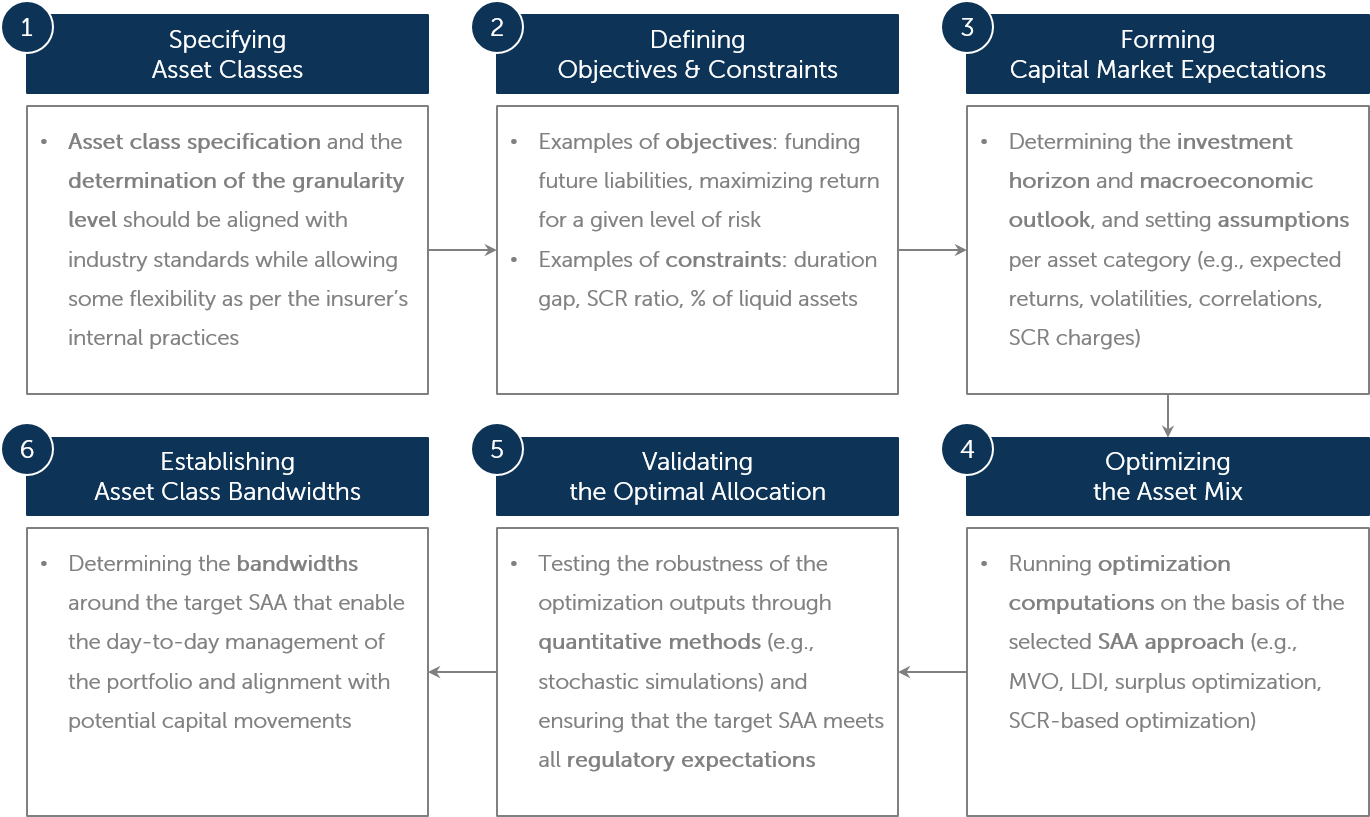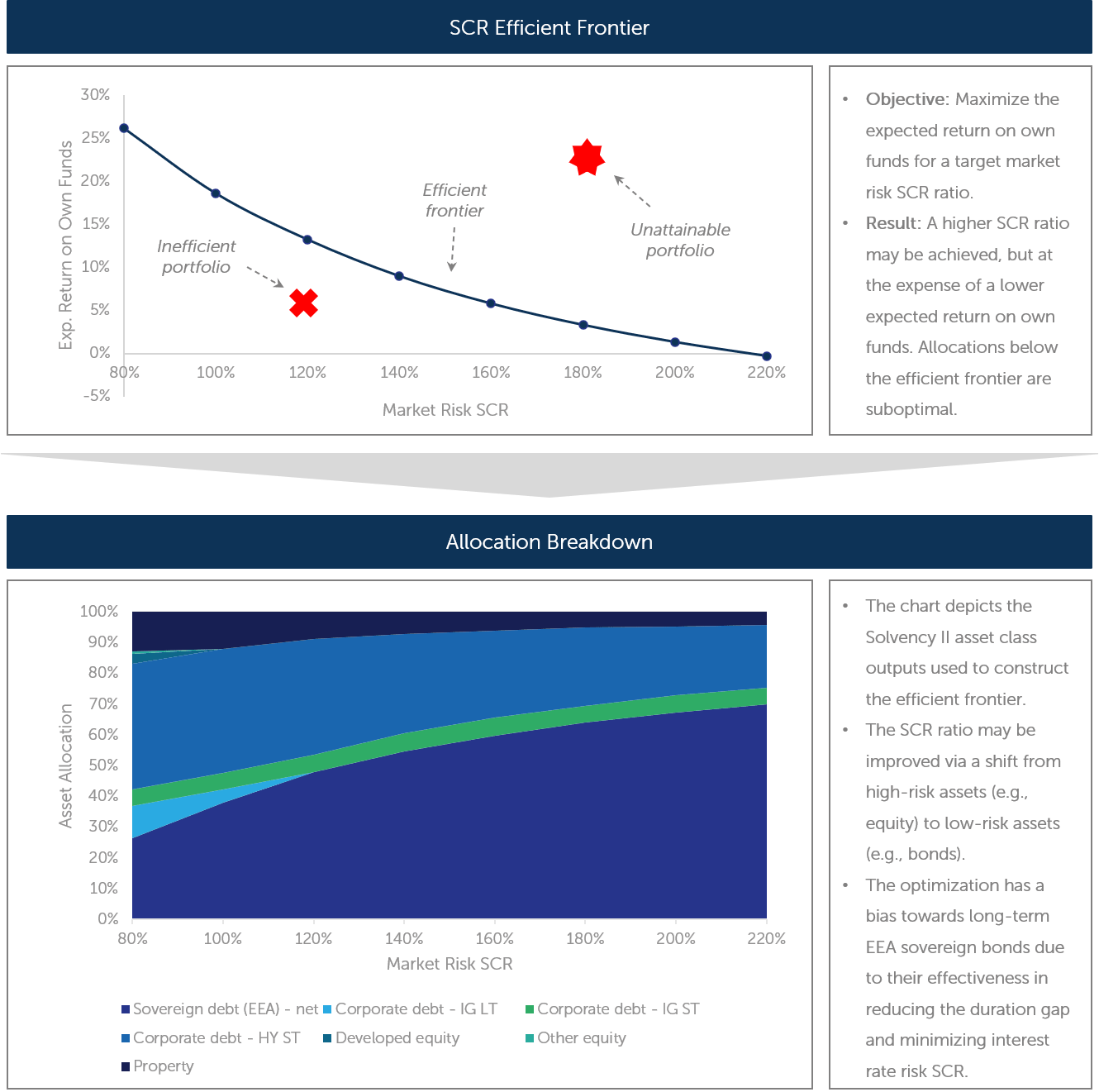Strategic Asset Allocation (SAA) for Insurers
Our Strategic Asset Allocation (SAA) approach operates with a long-term planning perspective, employing robust investment management principles. We employ a dynamic asset allocation strategy geared toward achieving your investment objectives, whilst factoring in pre-set investment constraints and risk tolerance levels.
The determination of the optimal SAA is a complex, multifaceted process that involves balancing risk and return. It requires collaboration from multiple internal functions such as Asset Management, Asset Liability Management (ALM), and Risk Management. It also necessitates addressing the interests of external stakeholders, including shareholders, policyholders, and regulators.
At Finalyse, we bridge this gap by incorporating an academic perspective with a pragmatic approach to defining the target SAA. Our tailored solutions guide insurers in managing the intricacies of this balancing act at every step of the process. This approach allows you to secure optimal asset allocations that align with your risk tolerance, investment return objectives and insurance business specificities. Our goal is to provide a dynamic, robust foundation, enabling you to navigate market challenges and capitalise on growth opportunities.
How does Finalyse address your challenges?
Develop and Implement SAA Optimisation Model and Calculation Engine
Design and Implement an End-to-End Process for the Target SAA's Definition
Integrate Capital Planning, Balance Sheet Management and the Risk Appetite Framework
Align with Regulatory Requirements, like ORSA and the Standard Formula Appropriateness Assessment
Model the Best Estimate Liability cash flows and their Relationship with Asset Cash Flows
Design Derivatives Hedging Strategies for Managing DV01 and CS01
How does it work in practice?
Target SAA determination – the process:

Visualizing the optimal allocation – an example:

Key Features
- A properly defined SAA is crucial for managing the insurer’s solvency and liquidity risks, while generating returns sufficient to meet policyholder pay-outs and maximize shareholder wealth.
- Given the ever increasing regulatory scrutiny in the context of the European Solvency II framework, the SAA must respect the fundamental guiding principles and accepted market practices.
- Finalyse offers extensive experience and expertise on both the asset and liability sides, which provides the necessary scope of knowledge and skills to help determine the SAA that is optimal for your business.

Frans is an actuary and Financial Risk Manager with international experience in the pensions and insurance sectors. He has been specialising in actuarial valuations (AXIS), financial and regulatory reporting (IAS19, US GAAP, IFRS2, IFRS17), regulatory reporting (IORP II, Solvency II, ICS, BMA), market risk management (ALM, SAA), climate change risk management and investment consulting.

François-Xavier is a Principal Consultant with advanced expertise in Financial Markets, ALM and Risk Management, covering both banks and insurance companies. On the banking side, François-Xavier is a practice leader on Valuation, IRRBB, FRTB, VaR, Initial Margin and Counterparty Risk, well acquainted with the regulatory requirements and the market practices surrounding market risks. On the insurance side, François-Xavier has extended experience in the regulatory treatment of financial instruments, ORSA, and hedging balance sheets against interest rate, credit spread and inflation risks.
Finalyse InsuranceFinalyse offers specialized consulting for insurance and pension sectors, focusing on risk management, actuarial modeling, and regulatory compliance. Their services include Solvency II support, IFRS 17 implementation, and climate risk assessments, ensuring robust frameworks and regulatory alignment for institutions. |

Our Insurance Services
Check out Finalyse Insurance services list that could help your business.
Our Insurance Leaders
Get to know the people behind our services, feel free to ask them any questions.
Client Cases
Read Finalyse client cases regarding our insurance service offer.
Insurance blog articles
Read Finalyse blog articles regarding our insurance service offer.
Trending Services
BMA Regulations
Designed to meet regulatory and strategic requirements of the Actuarial and Risk department
Solvency II
Designed to meet regulatory and strategic requirements of the Actuarial and Risk department.
Outsourced Function Services
Designed to provide cost-efficient and independent assurance to insurance and reinsurance undertakings
Finalyse BankingFinalyse leverages 35+ years of banking expertise to guide you through regulatory challenges with tailored risk solutions. |

Trending Services
AI Fairness Assessment
Designed to help your Risk Management (Validation/AI Team) department in complying with EU AI Act regulatory requirements
CRR3 Validation Toolkit
A tool for banks to validate the implementation of RWA calculations and be better prepared for CRR3 in 2025
FRTB
In 2025, FRTB will become the European norm for Pillar I market risk. Enhanced reporting requirements will also kick in at the start of the year. Are you on track?
Finalyse ValuationValuing complex products is both costly and demanding, requiring quality data, advanced models, and expert support. Finalyse Valuation Services are tailored to client needs, ensuring transparency and ongoing collaboration. Our experts analyse and reconcile counterparty prices to explain and document any differences. |

Trending Services
Independent valuation of OTC and structured products
Helping clients to reconcile price disputes
Value at Risk (VaR) Calculation Service
Save time reviewing the reports instead of producing them yourself
EMIR and SFTR Reporting Services
Helping institutions to cope with reporting-related requirements
Finalyse PublicationsDiscover Finalyse writings, written for you by our experienced consultants, read whitepapers, our RegBrief and blog articles to stay ahead of the trends in the Banking, Insurance and Managed Services world |

Blog
Finalyse’s take on risk-mitigation techniques and the regulatory requirements that they address
Regulatory Brief
A regularly updated catalogue of key financial policy changes, focusing on risk management, reporting, governance, accounting, and trading
Materials
Read Finalyse whitepapers and research materials on trending subjects
Latest Blog Articles
Contents of a Recovery Plan: What European Insurers Can Learn From the Irish Experience (Part 2 of 2)
Contents of a Recovery Plan: What European Insurers Can Learn From the Irish Experience (Part 1 of 2)
Rethinking 'Risk-Free': Managing the Hidden Risks in Long- and Short-Term Insurance Liabilities
About FinalyseOur aim is to support our clients incorporating changes and innovations in valuation, risk and compliance. We share the ambition to contribute to a sustainable and resilient financial system. Facing these extraordinary challenges is what drives us every day. |

Finalyse CareersUnlock your potential with Finalyse: as risk management pioneers with over 35 years of experience, we provide advisory services and empower clients in making informed decisions. Our mission is to support them in adapting to changes and innovations, contributing to a sustainable and resilient financial system. |

Our Team
Get to know our diverse and multicultural teams, committed to bring new ideas
Why Finalyse
We combine growing fintech expertise, ownership, and a passion for tailored solutions to make a real impact
Career Path
Discover our three business lines and the expert teams delivering smart, reliable support


